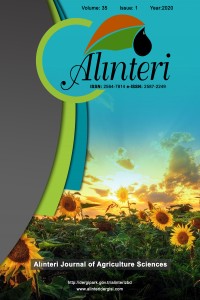Öz
Kaynakça
- Anwarul-Huq, A.S.M., Alam, S. and Sabur, S.A. (2004). Estimation of potato demand elasticities inBangladesh. Bangladesh Journal of Agricultural Economics, XXVII (1):1-13
- Awal, M.A., Sabur, S.A. andMia, M.I.A. (2008). Estimation of vegetable demand elasticities inBangladesh: Application of Almost IdealDemand System Model.Bangladesh Journal ofAgricultural Economics, XXXI (1):35-60
- Babar, A., Khalil, M., Zahid, I. and Ijaz, H. (2011). Estimating food demand elasticities in Pakistan: An Application of Almost Ideal Demand System. Forman Journal of Economic Studies, 7:1-24
- Blanciforti, L. and Green, R. (1983) An Almost Ideal Demand System incorporating habits: An analysis of expenditure on food and aggregate commodity groups. Review of Economic and Statistics, 511-15
- Haq, U.Z., Nazli, H., Meilke, K., Ishaq, M., Khattak, A., Hashmi, A.H. and Rehman, F.U. (2011). Food demand patterns in Pakistani Punjab. Sarhad Journal of Agriculture, 27(2):305-311
- Makama, S.A. Ilu, Y.I., Suleiman, N.J., Isiaku, S. and Isah, M.A. (2017). Demand Analysis of Rice in Nigeria. Nigerian Journal of Agricultural Extension, 18(3):70-75
- Mudassar, K., Aziz, B. and Anwar, A. (2012). Estimating consumer demand of major food itemsin Pakistan: A micro data analysis. Pakistan Journal of Life Social Sciences, 10(1):53-58
- Theil, H. (1965). The information approach to demand analysis. Econometrica, 33(1):67-82.
Öz
The present research empirically study the demand pattern of cereal commodities for domestic use in Nigeria using time series data which spanned from 1966 to 2018. The data covered the domestic quantities and price series of the five most important domestically used cereal commodities. The sources of the data were FAO and USDA databases and the collected data were analyzed using descriptive statistics and linear approximate almost ideal demand system (LA/AIDS). The empirical evidence showed that all the considered goods were normal goods and mostly a necessity except for wheat which is a luxury. In addition, domestic consumption of these commodities was sensitive to changes in their respective prices. With wheat been a luxury commodity, it can be inferred that an increase in per capita income would tend to bring about a paradigm shift from the consumption of staple foods to non-staple food (wheat). This indicates that households tend to diversify their diet composition. Also, it was observed that most of the good pairs are complementary (uncompensated cross-price elasticity) while on the other hand (compensated cross-price elasticity), most of the good pairs are substitutes. The empirical evidence showed the income effect which owes to price changes for all the selected commodities to be moderate. Therefore, onus lies on the policymakers to embark on mass production of wheat in order to free the country from wheat food insecurity bondage caused by external influence, an impediment to the barometer that strikes a balance between the forces of demand and supply.
Anahtar Kelimeler
Domestic use LA/AIDS model Demand Cereal commodities Nigeria
Kaynakça
- Anwarul-Huq, A.S.M., Alam, S. and Sabur, S.A. (2004). Estimation of potato demand elasticities inBangladesh. Bangladesh Journal of Agricultural Economics, XXVII (1):1-13
- Awal, M.A., Sabur, S.A. andMia, M.I.A. (2008). Estimation of vegetable demand elasticities inBangladesh: Application of Almost IdealDemand System Model.Bangladesh Journal ofAgricultural Economics, XXXI (1):35-60
- Babar, A., Khalil, M., Zahid, I. and Ijaz, H. (2011). Estimating food demand elasticities in Pakistan: An Application of Almost Ideal Demand System. Forman Journal of Economic Studies, 7:1-24
- Blanciforti, L. and Green, R. (1983) An Almost Ideal Demand System incorporating habits: An analysis of expenditure on food and aggregate commodity groups. Review of Economic and Statistics, 511-15
- Haq, U.Z., Nazli, H., Meilke, K., Ishaq, M., Khattak, A., Hashmi, A.H. and Rehman, F.U. (2011). Food demand patterns in Pakistani Punjab. Sarhad Journal of Agriculture, 27(2):305-311
- Makama, S.A. Ilu, Y.I., Suleiman, N.J., Isiaku, S. and Isah, M.A. (2017). Demand Analysis of Rice in Nigeria. Nigerian Journal of Agricultural Extension, 18(3):70-75
- Mudassar, K., Aziz, B. and Anwar, A. (2012). Estimating consumer demand of major food itemsin Pakistan: A micro data analysis. Pakistan Journal of Life Social Sciences, 10(1):53-58
- Theil, H. (1965). The information approach to demand analysis. Econometrica, 33(1):67-82.
Ayrıntılar
| Birincil Dil | İngilizce |
|---|---|
| Konular | Ziraat, Veterinerlik ve Gıda Bilimleri |
| Bölüm | Araştırma Makaleleri |
| Yazarlar | |
| Yayımlanma Tarihi | 30 Haziran 2020 |
| Kabul Tarihi | 13 Nisan 2020 |
| Yayımlandığı Sayı | Yıl 2020 Cilt: 35 Sayı: 1 |


